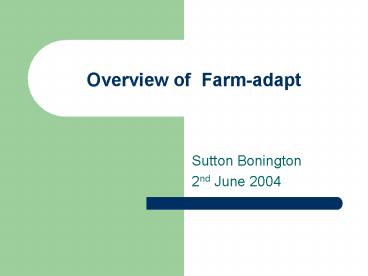Overview of Farmadapt - PowerPoint PPT Presentation
1 / 15
Title:
Overview of Farmadapt
Description:
How will farmers, assuming profit maximisation ... Clairvoyant' farmer: has perfect foresight. What farmers should' do, policy making ... – PowerPoint PPT presentation
Number of Views:47
Avg rating:3.0/5.0
Title: Overview of Farmadapt
1
Overview of Farm-adapt
- Sutton Bonington
- 2nd June 2004
2
Purpose
- How can farmers, at least financial cost
- reduce nitrate emissions?
- reduce GHG emissions?
- adapt to climate change?
- adapt to CAP reform?
- How will farmers, assuming profit maximisation
- adapt to reduced water resources and increased
irrigation demand?
3
Farmer decisions
- Crop mix and animals owned
- Timing of operations
- Labour (employed, casual and contract)
- Machinery owned
- Investment in buildings
- Investment in reservoir and irrigation capacity
4
Implementation of core model 1
- Farm level model, simulates single or many farms
- captures the many options available to farmer
- Mixed integer linear programming (MIP) model
- maximises Farm net margin (? profit)
- subject to constraints
- available land
- labour machinery requirement to grow crops
- integers labour, machinery, switches
5
Implementation of core model 2
- The model is has not been parameterised by
fitting to data - known policy constraints, e.g. minimum set-aside
land area - assume farmer is following current good
practice, published guidelines, e.g. fertiliser
recommendations, animal diets - several piecewise linear approximations
- uses published estimates, e.g. field workrates
6
Implementation of core model 3
- Inputs to model from many sources, varies
depending on context - other models, written by others
- crop growth models
- soil nitrogen models (nitrate/nitrous oxide
emissions) - ruminant digestion models (methane emissions)
- hydrology models (irrigation availability)
- survey data (e.g. actual farm crop yields)
- historical or estimates of future prices
7
Implementation of core model 4
- Uses Xpressmp optimization software
- libraries for matrix generation and optimization
- multiple ways to access libraries
- native language (primitive Pascal dialect),
compiled to byte code, runs on virtual machine - C, C, Java, Visual Basic
- different levels of access, raw matrix to total
abstraction - all model code written by us
8
How can farmers?
- Single farm
- Weekly time step
- Annual model
- Profit maximizing
- Clairvoyant farmer has perfect foresight
- What farmers should do, policy making
9
Robustness and uncertainty
- We want to recommend farm plans that are robust
to uncertainty in inputs and to natural
variability - not only applicable to average farm in average
year - sensitivity analysis
- Monte Carlo simulation using output from input
models, compare fixed farm plans with adaptation
to each set of inputs
10
How will farmers? 1
- Multi-farm, allows trading of resources
- Weekly time step
- Multi-annual model
- Profit maximizing
- Smart farmer uses knowledge from previous
years - What farmers will do
11
How will farmers? 2
- Each year has a two step process
- Farmer makes planning decisions at the start of
the year using expected crop yields, irrigation
requirements, and water availabilities calculated
from previous four years - Annual actual outcome determined by farm plan,
actual crop yields, irrigation requirements and
water availability
12
Multi-annual 1 climate change
- Fifty years of crop yields and irrigation
requirements for each period (baseline, 2020s
2050s) from crop model - Bootstrap sample from each period to create a
pseudo-sequence 1983-2079 - Run model over period, investments in each year
carried over to next year - Repeat with new sample x100
13
Yield sampling for pseudo-sequence
1) Crop yield data
50x Baseline Yields
50x 2020 Yields
50x 2050 Yields
2) Bootstrap sample
3) Pseudo- sequence
1983
2020
2050
2079
4) Model run
1987
14
Multi-annual 2
- Samples with sequences of dry years effect on
irrigation investment cropping - Compare intra-period with inter-period variation
- Sampling methodology means probability of
outcomes can be estimated
15
Model selection and Farm-adapt
- Not a regression or fitted model, AIC/BIC etc.
cannot be directly applied - Model over-complex?
- too flexible (? over-fitted?)
- which bits to remove?
- Many alternative sub-optimal solutions
- almost as good/more realistic?
- how similar/different to optimal solution?































